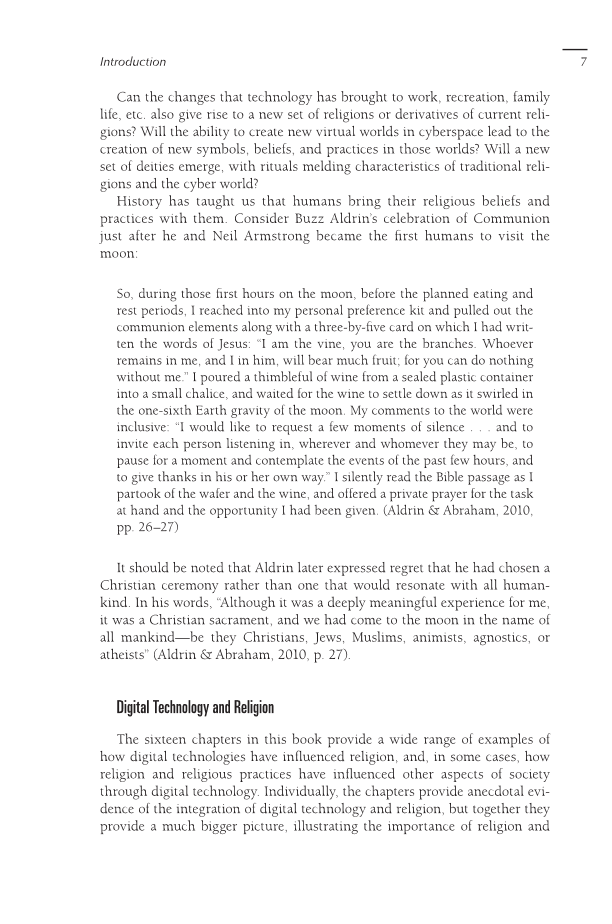Introduction 7 Can the changes that technology has brought to work, recreation, family life, etc. also give rise to a new set of religions or derivatives of current reli- gions? Will the ability to create new virtual worlds in cyberspace lead to the creation of new symbols, beliefs, and practices in those worlds? Will a new set of deities emerge, with rituals melding characteristics of traditional reli- gions and the cyber world? History has taught us that humans bring their religious beliefs and practices with them. Consider Buzz Aldrin’s celebration of Communion just after he and Neil Armstrong became the first humans to visit the moon: So, during those first hours on the moon, before the planned eating and rest periods, I reached into my personal preference kit and pulled out the communion elements along with a three-by-five card on which I had writ- ten the words of Jesus: “I am the vine, you are the branches. Whoever remains in me, and I in him, will bear much fruit for you can do nothing without me.” I poured a thimbleful of wine from a sealed plastic container into a small chalice, and waited for the wine to settle down as it swirled in the one-sixth Earth gravity of the moon. My comments to the world were inclusive: “I would like to request a few moments of silence . . . and to invite each person listening in, wherever and whomever they may be, to pause for a moment and contemplate the events of the past few hours, and to give thanks in his or her own way.” I silently read the Bible passage as I partook of the wafer and the wine, and offered a private prayer for the task at hand and the opportunity I had been given. (Aldrin & Abraham, 2010, pp. 26–27) It should be noted that Aldrin later expressed regret that he had chosen a Christian ceremony rather than one that would resonate with all human- kind. In his words, “Although it was a deeply meaningful experience for me, it was a Christian sacrament, and we had come to the moon in the name of all mankind—be they Christians, Jews, Muslims, animists, agnostics, or atheists” (Aldrin & Abraham, 2010, p. 27). Digital Technology and Religion The sixteen chapters in this book provide a wide range of examples of how digital technologies have influenced religion, and, in some cases, how religion and religious practices have influenced other aspects of society through digital technology. Individually, the chapters provide anecdotal evi- dence of the integration of digital technology and religion, but together they provide a much bigger picture, illustrating the importance of religion and
Document Details My Account Print multiple pages
Print
You have printed 0 times in the last 24 hours.
Your print count will reset on at .
You may print 0 more time(s) before then.
You may print a maximum of 0 pages at a time.













































































































































































































































































































































































































































































































































































































































